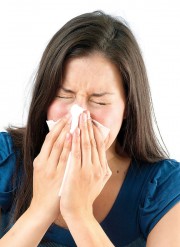 The differences can sometimes be subtle. Common to all three problems is irritation and inflammation of the lining of the nose and sinuses, causing nasal congestion, runny nose, and facial pressure.
The differences can sometimes be subtle. Common to all three problems is irritation and inflammation of the lining of the nose and sinuses, causing nasal congestion, runny nose, and facial pressure.
Sinonasal allergies result when certain substances, typically airborne allergens, gain access to the body through the throat and nose, and stimulate the release of histamine. The histamine, and other chemicals released by the body, cause the lining of the nose and sinuses to swell, resulting in increased mucus production and congestion.
Itchiness of the nose, eyes, and throat can be symptoms of allergies, and are similar to those of the common cold, which is caused by viruses. Symptoms of a cold may also include a sore throat and cough. Colds typically last 7-10 days in duration and resolve without antibiotics.
Both allergies and colds cause inflammation of the mucous membranes of the nasal passages and sinuses. This can cause the drainage openings of the sinuses to close off, resulting in sinusitis. If symptoms have lasted for over a week, the nasal drainage is greenish in color, and you have developed a fever, then you may have developed sinusitis. Antibiotics may be required to treat sinusitis. An otolaryngologist can diagnose sinusitis by looking into the nasal passages and sinuses.
Treatment
Over-the-Counter: Relief from many symptoms of allergies, colds and sinusitis is available without a prescription. Over-the-counter (OTC) decongestants and anti-histamines can be very effective; however, you should consult your physician to make sure that they are right for you. One very safe and soothing method of treatment is a simple salt-water (saline) flush or spray. This is a recommended mainstay of treatment for those suffering from sinonasal allergies, as it is an effective way of removing the irritant (allergen), thus preventing swelling and nasal congestion.
When to see a doctor: If symptoms persist for several weeks, and no improvement is seen with OTC meds, consult your physician or otolaryngology specialist. The otolaryngologist can determine if the problem is allergies or sinusitis, prescribe antibiotics if necessary, and determine whether there is an anatomic problem, such as a septal deviation, that is contributing to the condition.
Treatment for Allergies
Allergies affect some 20 million Americans. They represent an abnormal immune response to an environmental protein that is ordinarily tolerated. Symptoms are initiated by inhalation of dander, pollen, mold spores, or other antigens. Typically, trees pollinate and cause symptoms in the spring, grasses pollinate in the summer, and weeds, such as ragweed, pollinate in the fall. Allergens, such as house dust mites, cockroaches, animal dander, and molds, can cause symptoms year-round.
There are three mainstays of treating inhalant allergies:
- Allergen avoidance
- Pharmacotherapy
- Immunotherapy
Allergen avoidance: Avoidance of exposure to the specific substance that one is allergic to. For example, house dust mite sensitivity requires control of bedroom dust, special carpet cleansers, HEPA filter, etc.
Pharmacotherapy: This includes antihistamines (oral or nasal topical), nasal steroid sprays, decongestants, topical nasal cromolyn, or oral antileukotrienes. This form of therapy is often done before allergy testing. If symptoms respond well, the medication is continued as needed, and allergy testing may not be necessary.
Allergy Testing: Allergy tests are performed using either skin tests or blood tests. There are two types of skin tests: scratch testing and intradermal testing. During a scratch test, a drop of allergen is scratched on the surface of the skin. If a patient is allergic, redness and swelling will appear at the site. If the scratch test is inconclusive, the physician may perform an intradermal test where small amounts of allergen are injected into the surface of the skin. Both types of skin tests are relatively painless.
Immunotherapy
Immunotherapy increases an individual’s tolerance to the substances that provoke the allergy symptoms. Typically, immunotherapy involves weekly allergy shots. This treatment is a mainstay of therapy; however, it has some intrinsic downsides: injections and weekly trips to the doctor’s office.
Sublingual Immunotherapy
In a new alternative therapy called sublingual immunotherapy, drops of the allergen solution are placed under the tongue. The solution is given in increasingly stronger doses for four months, and then levels off. Widely used in Europe and endorsed by the World Health Organization, sublingual immunotherapy is available in the United States; however, it is not covered by insurance nor officially approved by the FDA.
Sublingual immunotherapy has been shown to improve allergy symptoms, decrease the need for medicine, decrease asthma attacks, and decrease the chance of developing asthma in allergic children. The approach is particularly useful in treating children or those fearful of needles. It can be done at home and (like injections) must be continued for 3-5 years to maximize long-lasting effects.
Dr. Kato is the founder of The Ear Institute in Palm Desert. Her top priority is improving the quality of life of her patients. Dr. Kato can be reached at: 760-565-3900.
References: 1) Sublingual immunotherapy.; Lin SY, Leatherman B.Otolaryngol Clin North Am. 2011 Jun;44(3):753-64, x-xi. 2) Treatment of mild to moderate sinusitis. Smith SR, Montgomery LG, Williams JW Jr. Arch Intern Med. 2012 Mar 26;172(6):510-3. Review.; 3) Sub-Lingual Immunotherapy World Allergy Organization Position Paper 2009








































Comments (0)